
views
Doing a Simple Rolled Up-Do

Brush your hair, then part it down the middle. Use the handle of a rat-tail comb to do this. This method works best on shorter hair lengths. Anything between jaw and shoulder-length should work especially well. When complete, your hair will be coiled around a headband in an elegant up-do. If your hair is thin, consider adding some volumizing spray or mousse to it first.

Place an elastic headband over your head. Position the band so that the front is 1 to 2 inches (2.54 to 5.08 centimeters) from your front hairline. The back of the headband should be nestled right over your hair on the nape of your neck. Do not tuck the headband under your hair. Braided gold or silver headbands will work the best, but you can try a beaded one too. An even better option would be something with vines or leaves. The band should go around the entire head, instead of stopping behind your ears like a metal or plastic U-shaped headband would.
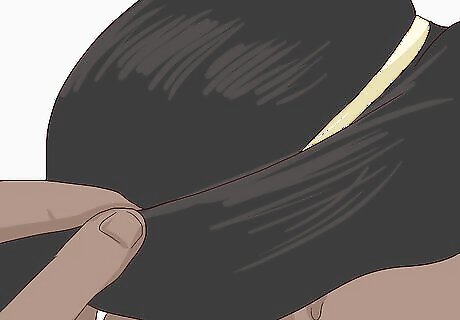
Take a lock of hair from the front of your head. Gather a section of hair from one side of the part. The hair needs to extend from the part to just in front of your ear.
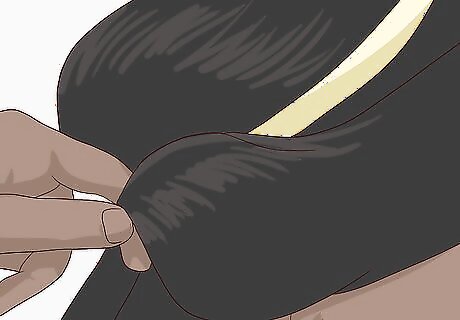
Twist the hair, then tuck it under the headband. Give the lock of hair a single twist with your finger. Pull it upwards, then tuck it under the headband. Gently pull it downwards. Keep the hair loosely wrapped around the headband; you should be able to slide your finger through the gap.

Gather the next section of hair. Gather a 1 to 2-inch (2.54 to 5.08-centimeter) wide section right next to the wrapped hair. Be sure to include the hair you just tucked under the headband.

Wrap the hair around the headband as well. Keep gathering sections of hair and wrapping them over and under the headband until you reach the back of your head. Once again, wrap your hair loosely around the headband. This hides the actual headband and makes your hair appear as if it is the headband.

Repeat the process on the other side of your head. When you reach the back of your head, stop. You will likely have a tail of hair sticking out of your nape, between the two wrapped sections.
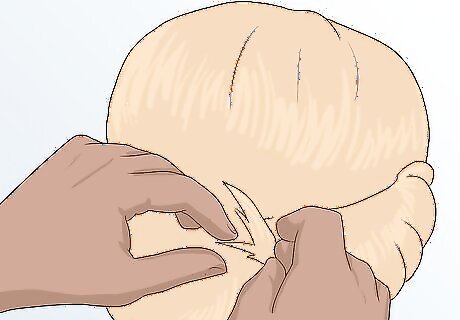
Coil the tail and pin it in place. Use your fingers to coil the tail upwards, so that it matches the rest of the wrapped hair. Tuck it against the back of your head, and secure it with bobby pins. Use bobby pins that match your hair color. Slide the bobby pins through the inside of the coil, not the outside.

Loosen the up-do, if needed. Gently tug on the hair above the wrapped hair to loosen it up and make it more puffy. You can also muss up the wrapped hair as well. Do not get carried away, however; you don't want your up-do to loose messy or disheveled. too much manipulation can cause your hair to look frizzy.
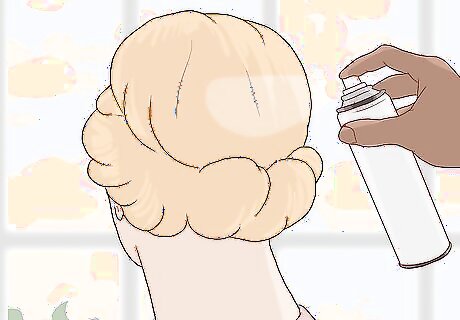
Set the style with hairspray. Focus the hairspray on the bottom portion of your hair, where you wrapped the locked around the headband. Once the hairspray dries, you are ready to go!
Doing a Braided and Curled Up-Do

Brush your hair until it is free of knots and tangles. This method works best with longer hair, but you might be able to do it if you have shoulder-length hair too. When complete, this style will resemble a braided crown with a bunch of loose curls inside it.

Consider curling your hair. You don't absolutely have to do this, but it will help give your hair more volume and texture. It will also make it easier to do the curled buns at the end. You can use any hair curling method you want for this. If your hair is naturally curly, you don't have to curl it.
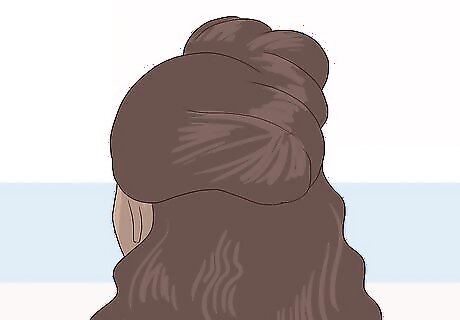
Pull you hair into a ponytail or bun, but leave a border around it. Use the handle of a rat-tail comb to create a part that goes all the way around your head, 2 to 3 inches (5.08 to 7.62 centimeters) from your hairline. Pull the hair within that border into a ponytail or bun. You should have a 2 to 3-inch (5.08 to 7.62-centimeter) thick border of loose hair all around your head.

Part your loose hair and begin a normal braid. Use the handle of a rat-tail comb to create a center or side part in your loose hair; be careful not to disturb the bun or ponytail. Take a section from the right side of the part, and split it into three strands. Cross the left and right strands over the middle one.

Continue with a French braid until you reach your left ear. Add some hair to the left strand, and cross it over the middle strand. Add some more hair to the right strand, and cross it over the middle one as well. Continue French braiding down the side of your head, across the nape, and up the left side. Stop when you reach your ear. If you have shoulder-length or shorter hair, braid just past your ear. Make sure that you include all of the loose hair into the French braid.
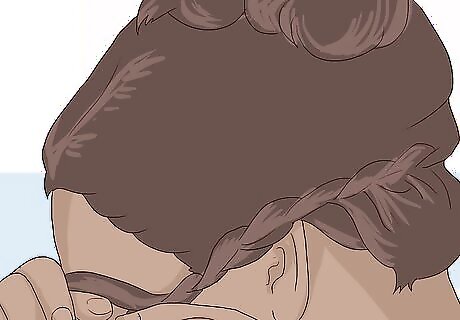
Finish off a regular braid. Gather all of the remaining loose hair from the left side of your hair. Add them to the left, right, and middle strands, distributing them evenly. Braid the strands together in a normal braid, then secure them with a clear hair elastic.

Wrap the braid over the top of your head, then secure it with bobby pins. It may reach the start of your French braid, or it may extend just past it. In either case, tuck the braid against the French braid, then secure with bobby pins. Be sure to tuck the tail end out of sight and to use bobby pins that match your hair color.

Undo the bun or ponytail at the top of your head. By now, you should have a braided crown wrapped around your head, like a headband. The hair at the top of your head, within that crown, should be loose.

Take a section of loose hair and rope braid it. Gather a section of loose hair. Split it into two thinner sections. Twist them loosely together to form a rope.

Scrunch the rope braid downward. Pinch the rope at the end between your thumb and forefinger. Grab a thin strand from the tail with your free hand. Keeping the hair pinched between your thumb and forefinger, slide it downward towards your head. This will create loose, curl-like coils of hair.

Twist the coiled braid into a loose bun, then secure it with bobby pins. Coil the scrunched-down rope braid into a loose bun. Hold it against your head, then secure it with a bobby pin (or two) that matches your hair color. The coil should be loose enough so that you can fit your finger through it.

Repeat the process to make more coiled buns. Work your way around the inside of the braided crown. If you have any loose hair left in the middle, twist and coil that into a bun as well.

Set your style with hairspray. Focus the hairspray on the coiled buns, which are more likely to come undone. Add a light misting all around the crown braid, then let the hairspray dry.
Doing a Twisted Braid

Brush your hair to ensure that it is free of knots and tangles. When complete, this style will resemble a thick, elegant braid. It will work the best for hair that goes past your arm.

Create a half-up, half-down ponytail at the crown of your head. Instead of gathering the hair from your hairline and forehead, gather the hair a few inches/centimeters back. You want it to be in line with your ears. Create the ponytail at about eyebrow level. Use the handle of a rat-tail comb to create a neat, even part.

Braid the half-up, half-down ponytail. Keep the braid stitches loose, but neat. Secure the braid at the other end with another clear hair elastic.

Part the loose hair at your front hairline. Once again, use the handle of a rat-tail comb to do this. You can create a center part, or a side part.

Take a section from the left side of the part, and twist it into a rope. Gather a section that spans from the part down to the top of your ear, or whatever level your half-up, half-down ponytail starts. Twist the section upwards into a tight rope.

Tuck the top into the first stitch on your braid. Poke your finger up through the first stitch on your braid. Hook it around the rope, then pull it out of the braid, bringing the rope with it. Gently tug on the rope, then let it fall naturally under the braid. Secure it to the braid with a bobby pin.

Repeat the process on the right side. Gather a section of loose hair from the right side of your head. Twist it upwards into rope, then tuck it into the next stitch on the braid as well. Secure it to the braid and the first rope with another bobby pin.

Continue the process down the length of your braid. Keep gathering thin sections of loose hair from your hairline and twisting them upwards into ropes. Tuck each rope through a stitch on the braid, and pin it to the previous rope. Keep the tails hidden under the braid.

Weave the rest of your hair into the braid. When you reach the nape of your neck, you will still have some hair left over. Split this hair into two sections, and twist them into ropes. Weave the sections into the braid until you reach the bottom, then secure them with another clear hair elastic.

Set your hair with hairspray. Give your braid a light misting of hairspray. Wait for the spray to dry, then go about your day!
Doing a Braided Headband

Brush your hair and part it down the center. This style is part up-do, and part loose. When finished, you will have long bangs framing your face, and a Dutch braid headband. The hair at the back of your head will be left loose and long. This style works best on hair that falls past your shoulders.

Clip the hair around your face out of the way. Use the handle of a rat-tail comb to separate a 1 to 2-inch (2.54 to 5.08-centimeter) wide section of hair from your hairline. Extend this section down the side of your head towards the front of your ear. Use a clip or a hair tie to separate this section front the rest of your hair. Repeat this step for the other side of your head. You will be excluding this hair from the Dutch braid crown in the following steps.

Begin a reverse braid on the left side of your part. Gather a 1-inch (2.54-centimeter) side section from the left side of you part, right behind the sectioned-off hair. Split the section into three strands, then begin a regular braid, crossing the left and right strands under the middle one.

Continue with a Dutch braid down the left side of your head. Add some hair to the left strand, then cross it under the middle one. Add some more hair to the right strand, then cross it under the middle one as well. Continue braiding until you reach the side of your nape. Make sure that you are crossing the left and right strands under the middle one. Stop braiding just before you reach the back of your hair. Do not add the hair from your nape into the braid.

Finish off with a regular braid. Again, do not add anymore hair to the left, right, and middle strands. Simple braid these strands together, then secure them with a clear hair elastic. Do not add the hair from the back of your head into this elastic.

Repeat the process on the other side of your head. Create another Dutch braid running from your part, down the side of your head, and towards the side of your nape. Stop just before reaching the back of your head, and finish off with a regular braid. You will have a section of loose, unbraided hair running down the back of your head.
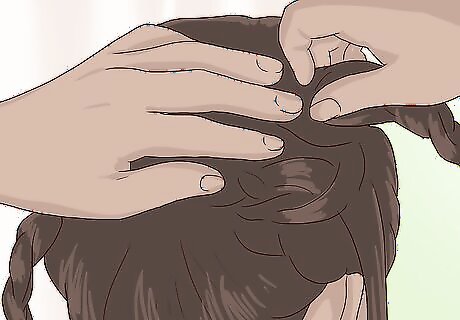
Wrap the left braid around the back of your head and pin it into place. Smooth down the loose hair between the two braids. Take the left braid, and wrap it around the back of your head, right over the loose hair. Pin it in place against the right Dutch braid. Tuck the tail under the braids, out of sight. Use bobby pins that match your hair color.

Repeat the process for the right braid. Wrap the right braid around the back of your head, crossing it over the left one. Tuck it up against the left Dutch braid, and pin it in place as well.

Unclip the hair from the front of your face. If your hair is very long, you can use a curling iron to add some soft curls to it. If you want to, you can use the handle of a rat-tail comb to add a side part to it instead. Be sure to add a heat protectant before curling your hair.

Curl the hair at the back of your head, if desired. By now, you should have loose hair framing your face, and a Dutch braid crown around your head, like a headband. You will have loose hair sticking out from under the crown at the back of your head. You can leave this hair as-is, or you can add some soft curls to it.
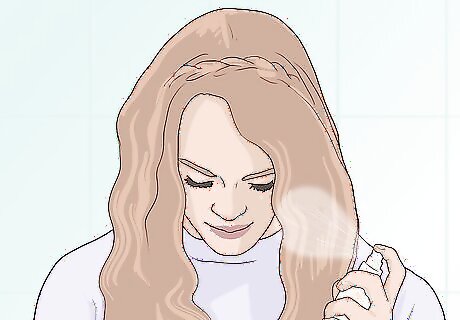
Set your style with hairspray. Give the Dutch braids a light misting of hairspray. If you added curls to you hair, it would be a good idea to spray them as well. Let the hairspray dry before setting out.














Comments
0 comment